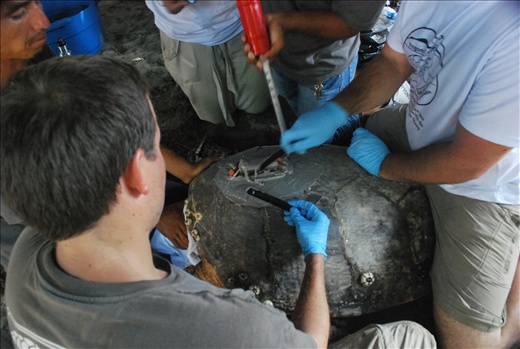To arrive to a new place in the dark is like tasting a new food with a blindfold on. You can feel the edges, but a full color appreciation isn’t possible until daylight arrives. Night time in the small town of La Pirraya on an island in Jiquilisco Bay is quiet; the fishermen and their families gather in small compounds preparing the day’s catch and saving energy for an early rise the next day. But hiding outside the lights of the town is the beginning of a conservation movement that could save one of the world’s most endangered populations of ocean wildlife.

My arrival to Jiquilisco Bay in southern El Salvador started at the small town of La Pirraya on the western side of the bay. Once our group, an international team of sea turtle conservationists, was settled into our rustic cabins, our night began. We received word of a nesting turtle and set off on a short boat ride up the beach.
Hawksbill turtles are known for nesting far up the beach, normally venturing into the beachside vegetation to lay their eggs. That knowledge didn’t prepare me for the location of this turtle, probably more than 50 feet inland on the other side of a barbed wire fence that was tall enough to keep people out but let turtles through underneath. That turtle was the perfect illustration of why this population remained hidden for so long; many turtle experts had considered the hawksbills of the Eastern Pacific functionally extinct until just a few years ago.
That turtle decided not to nest so a few of us broke off from the group to visit a hatchery where we waited for sunrise to inspect three hawksbills that were being held to put satellite transmitters on the next day. Along the way, we stopped the boat to see another hawksbill that was on another isolated stretch of beach.
Early the ext morning at the hatchery, I walked over to a four-foot deep pit where three large hawksbills were calmly waiting to be released. These turtles were much larger (their shells measured about 3 feet long) than the one small hawksbill I had worked with years before in Costa Rica; if I didn’t know better I would have thought they were a different species. There were also hatchlings to release, the most fun part of the job.
Our visit to Jiquilisco was organized by ICAPO (The Eastern Pacific Hawksbill Initiative) and these turtles are part of a study looking to unlock the mysterious life cycles of these turtles. Conservationists estimate fewer than 500 adult females left in their range, which goes from Mexico to Peru; almost half of them nests in this area. Until recently, researchers assumed that hawksbills only lived around coral reefs, of which there are relatively few along the Pacific coast. However, research by ICAPO and their partners has shown that these turtles live primarily in mangroves, a fact that surprised many turtle experts.
As we arrived back to La Pirraya, the town was in full swing, preparing for their annual hawksbill festival, complete with parade, dignitaries, throngs of media, and more. Dozens of students held homemade signs about protecting turtles and keeping trash out of the ocean and a few wore turtle costumes despite the quickly rising temperature. The highlight of the festival was attaching satellite transmitters to the shells of two hawksbills (you can follow them online here).

Many of the students stood outside a canopy, looking over the shoulders of the researchers to watch the process of attaching the transmitters. It took more than an hour to clean and sand the shells, place several layers of epoxy around the transmitter, and allow them to dry. Once completed, the turtles were taken to the water and released. The crowds were kept back to give the turtles room and once the turtles had their bearings, they went directly to the cool water, to be seen again in cyberspace.
I wish this story could have a neat and tidy ending with the turtles heading off into the water, their transmitters providing valuable information for years to come. However, a week later I got word that one of the hawksbills was already found dead. The likely culprit was blast fishing, a barbaric practice where fishermen use homemade bombs to kill everything in their range of impact. Read more about this tragedy on our partner EcoViva’s website here.
That news was a reminder that, despite a tremendous amount of progress protecting Jiquilisco Bay’s turtles over the past few years, there is still a lot of work to do. The first order of business is to ensure that the bay receives protection; ICAPO is hoping to guarantee protection of the critical hawksbill habitat, namely the 50 meter-wide area of beach along the nesting beaches and all of the marine habitat within the estuary. These actions by the government of El Salvador are the minimum necessary to give hawksbills the best shot at survival in the Eastern Pacific.
Get Involved:
Read more about ICAPO’s efforts to protect Jiquilisco Bay and how to volunteer with the program here.
Come visit Jiquilisco Bay in November with EcoViva.
Learn about SEEtheWILD’s Volunteer Vacations
Volunteer Work With Sea Turtles